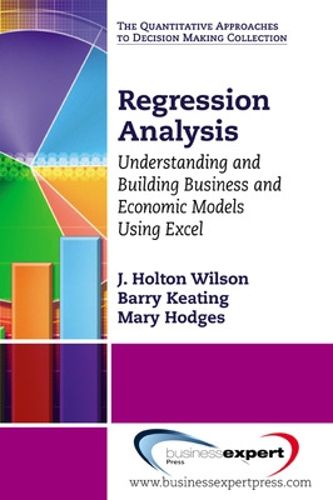Readings Newsletter
Become a Readings Member to make your shopping experience even easier.
Sign in or sign up for free!
You’re not far away from qualifying for FREE standard shipping within Australia
You’ve qualified for FREE standard shipping within Australia
The cart is loading…






This title is printed to order. This book may have been self-published. If so, we cannot guarantee the quality of the content. In the main most books will have gone through the editing process however some may not. We therefore suggest that you be aware of this before ordering this book. If in doubt check either the author or publisher’s details as we are unable to accept any returns unless they are faulty. Please contact us if you have any questions.
This book covers essential elements of building and understanding regression models within the context of business and economics. It is a nonmathematical treatment that is accessible, even to readers with limited statistical backgrounds. It is useful for business professionals, MBA students and others who seek to understand regression analysis without having to work through tedious mathematical and statistical theory. The importance of using regression models in modern business and economic analysis can hardly be overstated. In this book we describe exactly how such models can be developed and evaluated. The data used is real data with real world business applications, not data that has been contrived to demonstrate some purely academic point. These data are likely to be encountered and used in the actual world of business. In an appendix using screen shots and step by step instructions, we include how to do use Excel to perform regression analysis. When readers have completed this book they will understand how to build basic mathematical models illustrating business/economic relationships using regression analysis. In addition, they will know how to interpret and evaluate regression models using a five step process (which includes evaluating the model; identifying its statistical significance; determining its explanatory power; for time-series applications, identifying how the error terms are distributed; and understanding the concept of multicollinearity). Readers will understand what is possible and what to look for in evaluating regression models. It is unlikely that most readers will build such models in the course of carrying out their own professional responsibilities, but it is very likely that they will, at some point in their careers, be exposed to such models. This book will help such readers understand models that someone else has developed.
$9.00 standard shipping within Australia
FREE standard shipping within Australia for orders over $100.00
Express & International shipping calculated at checkout
This title is printed to order. This book may have been self-published. If so, we cannot guarantee the quality of the content. In the main most books will have gone through the editing process however some may not. We therefore suggest that you be aware of this before ordering this book. If in doubt check either the author or publisher’s details as we are unable to accept any returns unless they are faulty. Please contact us if you have any questions.
This book covers essential elements of building and understanding regression models within the context of business and economics. It is a nonmathematical treatment that is accessible, even to readers with limited statistical backgrounds. It is useful for business professionals, MBA students and others who seek to understand regression analysis without having to work through tedious mathematical and statistical theory. The importance of using regression models in modern business and economic analysis can hardly be overstated. In this book we describe exactly how such models can be developed and evaluated. The data used is real data with real world business applications, not data that has been contrived to demonstrate some purely academic point. These data are likely to be encountered and used in the actual world of business. In an appendix using screen shots and step by step instructions, we include how to do use Excel to perform regression analysis. When readers have completed this book they will understand how to build basic mathematical models illustrating business/economic relationships using regression analysis. In addition, they will know how to interpret and evaluate regression models using a five step process (which includes evaluating the model; identifying its statistical significance; determining its explanatory power; for time-series applications, identifying how the error terms are distributed; and understanding the concept of multicollinearity). Readers will understand what is possible and what to look for in evaluating regression models. It is unlikely that most readers will build such models in the course of carrying out their own professional responsibilities, but it is very likely that they will, at some point in their careers, be exposed to such models. This book will help such readers understand models that someone else has developed.